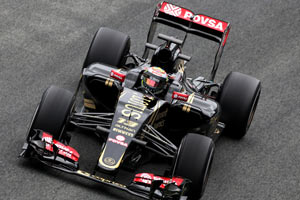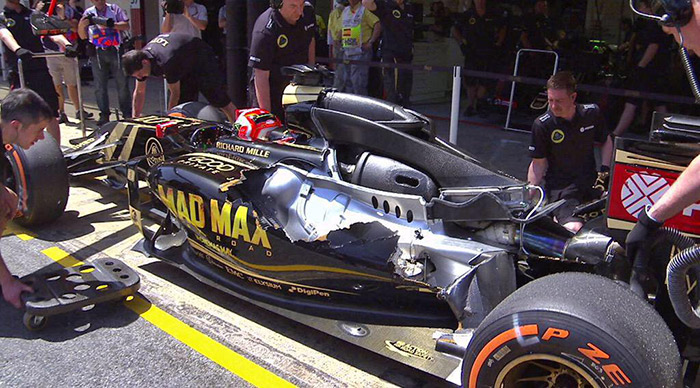Lotus E23 Hybrid Mercedes

Active: 2015
Team: Lotus F1 Team
Team: Nick Chester (TD), Nicolas Hennel (HA), Martin Tolliday (CD), Ayao Komatsu (CRE), Gerard Lopez (TP), Frederico Gastaldi (DTP), Matthew Carter (CEO)
Drivers: Romain Grosjean (8), Pastor Maldonado (13), Jolyon Palmer (3rd, Res)
The Lotus E23 was first fired up at the Lotus F1 Team base in enstone in the evening of Saturday 31st January, before the car was packed to leave for pre-season testing at Jerez. While other teams started running on 1 February, Lotus arrived late, and managed to debut their car on track on 2 February, ahead of the team's expectations.
Following up on the E22, Lotus removed some of its unconventional design elements to the recycle bin, and instead opted to be a little bit more conservative, and copy what other teams were running during 2014. As such, the twin tusk nose was removed, in favour of a very clean and narrow nose cone while the assimetry at the rear of the car was abandoned.
The team's main task however surely was integrating the new power unit, following their switch from Renault to Mercedes power. A long term deal was signed with Mercedes AMG High Performance Powertrains, also forcing the team to switch fuel and lubricants, as Mercedes mandates the use of Petronas products. The change payed off immediately, as the team managed to complete its entire pre-season testing programme with a single power unit, and without any powertrain issues that forced long periods in the boxes.
Along with it, the team adapted the location of most engine ancillaries, as well as a a different cooling layout. During 2014, the water-to-air intercooler caused the team so many headaches, that it ditched the approach in favour of a more conventional air-to-air system.

"It’s been a challenge to fit the engine", said Nick Chester. "The rear surface of the chassis is quite different and we had to do a lot of work to have a neat installation," he added. "We’ve gone back to air to air charge air cooling because the packaging switch to Mercedes power on a short timeline meant we had to find a simple solution."
Apart from a peaky power delivery, energy recovery via the BBW system made the Lotus E22 extremely difficult to drive. Lotus therefore also worked hard to improve their system, opting not to have it supplied by Mercedes. Technical Director Nick Chester said towards the end of winter testing that the team was now happy with the system, allowing their drivers to find the car's limit easier.
At the final winter test, Lotus also added a new front suspension to their E23, resulting in more grip through slower corners. The team said the changes compounded with the car's new rear suspension, which had similarly been completely redesigned to work better with the now banned front-to-rear hydraulic link.
Results
As the team continued to slim down to get control of their cashflow, the atmosphere similarly went downhill as results failed to materialise. Repeatedly the team saw its driver encounter mechanical issues, get involved in crashes, and at two races even crash into each other. The positive highpoint came at the Belgian Grand Prix, where Romain Grosjean scored the team's only podium finish of the year by coming third.
The focus by then had been on securing a takeover for the team, which eventually succeeded by Renault taking back control of Enstone, the base from where they secured their 2005 and 2006 double championships.
The Lotus E23 was good for just 78 points and 6th place in the Constructors' Championship.
Specifications
Chassis: Carbon-fibre monocoque
Front suspension: Upper and lower wishbones, inboard springs and dampers actuated by push-rods
Rear suspension: Upper and lower wishbones, inboard springs and dampers actuated by pull-rods
Dampers: Penske
Brakes: AP 6 piston front and 4 piston rear calipers with carbon discs and pads
Transmission: Lotus eight speed seamless sequential semi-automatic shift plus reverse gear, gear selection electro-hydraulically actuated, titanium casing
Clutch: Carbon fibre plates
Electronics: FIA standard ECU and FIA homologated electronic and electrical system (as provided by MES)
Cooling system: Aluminium oil, water and gearbox radiators
Tyres: Pirelli, Fronts: 245/660-13, Rears: 325/660-13
Wheels: OZ Racing, forged magnesium alloy
Fuel system: ATL Kevlar-reinforced rubber bladder
Dimensions
Length: Undisclosed
Height: 950 mm (minus T camera)
Track width: 1,450 mm (front); 1,400 mm (rear)
Weight: 702kg (FIA mininum; incl. driver and lubricants, tank empty)
Width: 1,800 mm (FIA maximum)
Powertrain
Designation: Mercedes-Benz PU106B Hybrid
Type: Turbocharged, 90° 1.6l V6, assisted with kinetic and heat ERS
No of valves: 24 (4 per cylinder)
Fuel injection: High-pressure direct injection (max 500 bar, one injector/cylinder)
Pressure charging: Single-stage compressor and exhaust turbine on a common shaft
Bore: 80mm
Stroke: 53mm
Crank height: 90mm (minimum allowed)
Energy recovery system: Integrated Hybrid energy recovery via electrical Motor Generator Units
Energy Store: Lithium-Ion battery solution, between 20 and 25 kg
Fuel: PETRONAS Primax
Lubricants: PETRONAS Syntium
Gearbox & hydraulic oil: PETRONAS Tutela
